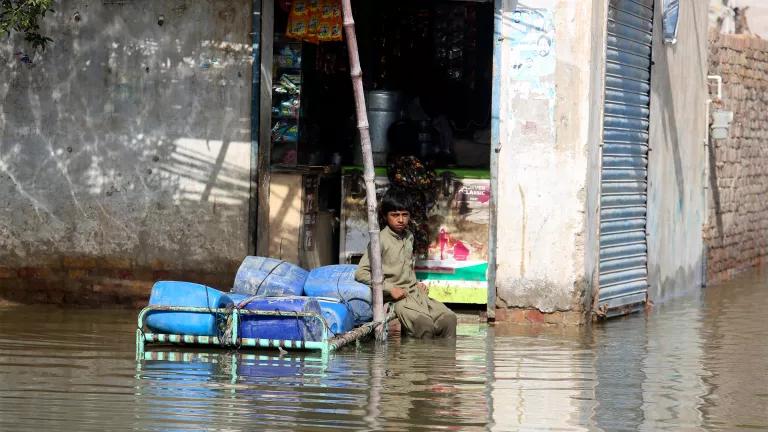IPCC 1.5°C Report: A Call to Transform Our Energy System
The IPCC Special Report on 1.5C calls for immediate reductions in coal, oil and gas to avoid lockin-in high-carbon infrastructure, and calls for a rapid scaling up of renewable energy.

These are the three main scenarios that avoid overshooting 1.5C. Given the controversies surrounding BECCS, the P1 scenario with rapid decreases in fossil fuel use presents the option with the most practical carbon removal assumptions.
The IPCC, the international organization tasked with assessing the science related to climate change, has just issued its special report on global temperature rise reaching 1.5 degree Celsius. What are the key points from this Summary for Policymakers? The world can still prevent warming exceeding 1.5°C, but this will require transformative actions at a global scale. In particular, the report calls for a far more rapid decline in the use of fossil fuels, more rapid scaling up of renewable energy taking advantage of the falling costs, and avoiding a lock-in of high-carbon infrastructure.
What Is the IPCC?
The Intergovernmental Panel on Climate Change (IPCC) is a part of the United Nations. It is tasked with providing policymakers with regular scientific assessments concerning climate change, detailing implications and potential future risks, and putting forward adaptation and mitigation strategies.
Special Report: “Global Warming of 1.5 °C”
This special report on 1.5°C was requested by multiple countries as a step towards implementing the Paris Agreement, in particular the call to limit temperature rise to 1.5°C rather than 2.0°C. At the time, 2.0°C was the commonly accepted target, but the most climate-vulnerable nations led the charge to push for 1.5°C because many nations would already be at severe risk from climate change at 1.5°C. As this latest report makes clear: “limiting global warming to 1.5°C, compared with 2°C, could reduce the number of people both exposed to climate-related risks and susceptible to poverty by up to several hundred million.”
What Are the Recommendations?
The Special Report makes clear that the world cannot prevent warming exceeding 1.5°C without initiating a decline in global CO2 emissions as soon as possible. Specifically, the Report finds that preventing an overshoot of 1.5°C requires decreasing CO2 emissions by about 45% from 2010 levels by 2030, reaching net zero around 2050. This will require massive reductions in the use of coal, oil and gas, as detailed below.
The portfolio of mitigation options recommended in the report include lowering energy and resource intensity, decarbonization by switching to low-carbon power sources, and carbon dioxide removal through afforestation and other potential options. The report included several “illustrative pathways” for reducing emissions, utilizing the portfolio of options in different combinations in each case.
Fossil Fuel Use Declines
In all of the major scenarios examined by the IPCC, fossil fuel use must decline. In Scenario P1 (see figure below), coal’s share of primary energy decreases 78% by 2030 (from 2010 levels) and must decrease 97% by 2050. This pathway presents the least risk, since it builds on current trends in the power sector, while not relying on options such as bio-energy with carbon capture and storage (BECCs) which have not been tested at scale. In that sense, it is the most ambitious scenario in terms of decreasing fossil fuel use. It offsets the remaining fossil fuel emissions through additional afforestation, land restoration and soil sequestration, which remove carbon from the atmosphere. The percent of energy coming from gas in 2030 must decline by 25% from 2010 levels and must decline 74% by 2050. The percent of energy coming from oil must decline by 37% by 2030 and 87% by 2050.
Scenario P2 requires a slightly slower rate of decline in fossil fuel use, by assuming more offsets for fossil fuel emissions through increased afforestation and a very limited BECCS deployment. In scenarios P2, P3 and P4 (not pictured), technologies such as BECCS are assumed to help reduce emissions while allowing a slower transition away from fossil fuels. However, it is right to question the practicality of scenarios with high BECCS assumptions. My colleague points out in a recent post the climate risks of BECCS: "There is no scientific basis for assuming that BECCS can deliver negative emissions after full emissions accounting for biomass in the power sector. Additionally, there is significant scientific basis to believe that harvesting biomass at a scale envisioned in a number of modeling scenarios would come at an untenable ecological cost." Thus, scenarios P2, P3 and P4 are riskier approaches to take where assumed carbon dioxide removal via BECCS may not come to fruition. In a worst case scenario, presumptions about carbon removal from BECCS allows for a buildout and continued reliance on fossil fuels for far too long, causing us to overshoot the 1.5°C goal.
Renewables Increase
Replacement with low carbon options takes center stage, as the “political, economic, social and technical feasibility of solar energy, wind energy and electricity storage technologies have substantially improved over the past few years.” Renewables are projected to supply 47-65% of electricity by 2030 and 69-87% of electricity by 2050.
It’s important to recognize that the rapid low carbon shift is more achievable than many would have guessed even a few years ago. As the report points out, such rapid and far-reaching transitions in energy and other sectors are “unprecedented in terms of scale, but not necessarily in terms of speed” as evidenced by rapid rates of change within specific sectors and technologies in the past.
Other options, such as hydrogen and carbon capture utilization and storage (CCUS), are “technically proven at various scales but their large scale deployment may be limited by economic, financial, human capacity and institutional constraints.” Put another way, renewables are less expensive than trying to keep fossil fuel power plants running with retrofits for carbon capture, for example.
Avoid Locking-In High Carbon Infrastructure
The report also warns against delayed action, to avoid the risks of “lock-in in carbon-emitting infrastructure, stranded assets, and reduced flexibility in future response options.” There is no time to waste, as nearly all feasibly pathways presented require cumulative global emissions to start falling by 2030. Given that reality, policymakers must deal with the reality that most new fossil fuel infrastructure currently being considered for investment should be cancelled, as the risk of becoming stranded assets in the future is high. While carbon removal options such as direct air capture have become a more important part of climate conversations recently, it is important not to allow co-option of the potential for carbon removal to justify slowing the necessary transition away from fossil fuels. Because "reliance on future large-scale deployment of carbon dioxide removal (CDR) can only be achieved if global CO2 emissions start to decline well before 2030."
One disappointing part about the final IPCC document is the removal of references to carbon pricing and the elimination of fossil fuel subsidies—two key measures that could eliminate the current biases in favor of coal, oil and gas. Nevertheless, the IPCC report should be a clear signal to policymakers that more stringent policies regulating fossil fuel production and consumption are needed to tackle climate change.
What’s Next?
Climate-related disasters such as intensified hurricanes, wildfires, record-breaking heat waves, and unprecedented flooding have been experienced by hundreds of millions across the globe. And this is only at about 1°C of warming. This IPCC special report makes it crystal clear why limiting warming to 1.5°C, rather than 2°C, is vital for our health and the health of the planet. As part of the Paris Agreement, nations put forward pledges to reduce emissions, but the sum total of these efforts would still allow future warming up to 3°C.
This report is a call to action, showing that we need to increase the ambition of the Paris Agreement to limit future emissions at 1.5°C rather than 2°C. More ambitious policy design and implementation to decarbonize the electricity sector are required. It’s time to hold our leaders and policymakers accountable to increase the ambition of national and subnational climate pledges, to be consistent with the path to a 1.5°C world.

